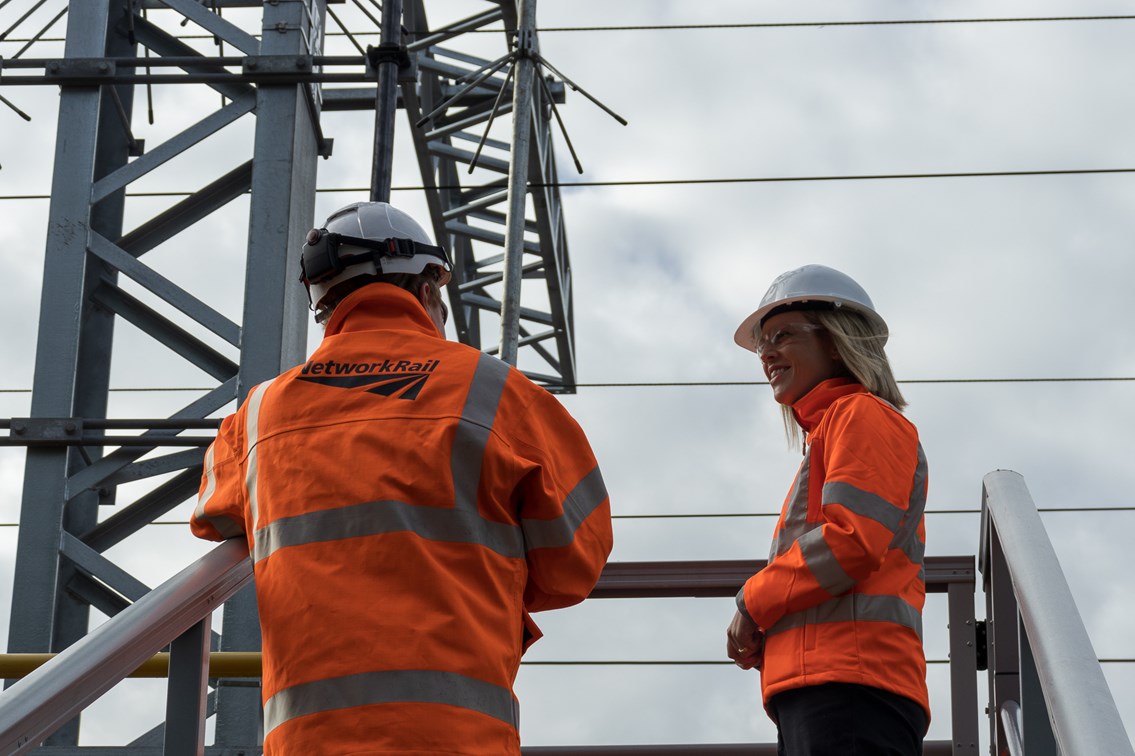Wednesday 17 Aug 2022
Transport Minister sees progress on feeder station upgrade programme
- Region & Route:
- Scotland’s Railway: Scotland
Scottish Government Transport Minister Jenny Gilruth visited the site of the first new feeder station to be commissioned as part of a £120m investment to boost the electricity supply into the railway network.
The Ferguslie feeder station, which will connect to the network in October, was installed near Paisley supports the existing infrastructure as well as providing the additional electric power needed to support future decarbonisation of Scotland’s railway.
The investment will see six new feeder stations at strategic locations across the network and a further nine sites upgraded to increase the resilience and reliability of the infrastructure for the operation of electrically powered passenger and freight traffic.
As well as increasing the resilience of the existing network, the new connections to the national grid via the feeder stations will increase the overall capability of the 25kV electrified network.
This will enable future passenger and freight growth and reduce the railway’s carbon footprint by supporting the removal of diesel passenger trains from the network.
It’s all part of efforts to make Scotland’s railway greener in line with the Scottish Government’s commitment to decarbonise the passenger rail network by 2035.
With the feeder-station installation and rail-side elements of the project largely complete, work to commission the Ferguslie site will shortly see Scottish Power Energy Networks (SPEN) install transformers to allow the feeder station to connect to the National Grid.
Following testing, the 132,000volt supply will be passed through the transformers and then sent through the feeder station to power the electrified railway network.
Jenny Gilruth, Transport Minister said, “It was great to be in Paisley today to meet the team and to hear more details about the work that will power newly electrified lines and also provides additional capacity to run more trains on the existing network.
“Upgrading the power supply network at this location will enable the introduction of electric trains on services to East Kilbride and Barrhead and this work will be replicated at five other locations across the central belt to support the Scottish Government’s railway decarbonisation programme. Our focus is on ensuring we can complete this work as quickly as possible as we work towards our net zero ambitions.
“We want a rail infrastructure for Scotland that helps to cut emissions, to provide sustainable transport for people and for freight, and which provides fair work and highly skilled employment opportunities. This project delivers greener travel options for people and for moving freight which will ultimately lead to the removal of many more vehicles from the roads in Scotland.”
Lesley Pringle, project manager for traction power at Network Rail said: “The £120m investment from the Scottish Government for this programme is key to helping us meet our target to decarbonise Scotland’s railway by 2035.
“Ferguslie is the first of the new feeder stations to be commissioned and it will boost the electricity supply to the rail network enabling greener and more sustainable travel options when the electrification projects are complete.
“We are continuing to work hard alongside our contractors and partners to commission this facility in October with a further five new feeder stations coming online between now and 2026.”
Notes to Editors
Work on the £120m investment to upgrade the network is underway. It will increase resilience and boost the power supply to increase the number of greener passenger and freight trains in Scotland.
Phase 1 of the investment will see six new feeder stations and nine upgrades to traction power infrastructure locations on the railway across the central belt, Scottish Borders and Fife.
Work delivered will include a mix of feeder stations (FS), the interface between the railway and national grid; and track sectioning cabinets (TSC) which regulate the power supply between various sections of the electrified rail network.
Upgrades to the power supply network will be ongoing until 2026.
Investment will increase the resilience of the existing network, the new connections to the national grid via the feeder stations will increase the overall capability of the 25kV electrified network.
Upgrading the power supply network will enable the introduction of electric trains on services to East Kilbride and Barrhead, on the Borders line and across Fife but will also support increased traffic on existing routes such as the East Coast Mainline.
Contact information
Passengers / community members
Network Rail national helpline
03457 11 41 41
Latest travel advice
Please visit National Rail Enquiries
Journalists
Network Rail press office - Owen Campbell
NR Press Office 0141 555 4108 / 07515 617073
Owen.Campbell1@networkrail.co.uk
About Network Rail
We own, operate and develop Britain's railway infrastructure; that's 20,000 miles of track, 30,000 bridges, tunnels and viaducts and the thousands of signals, level crossings and stations. We run 20 of the UK's largest stations while all the others, over 2,500, are run by the country's train operating companies.
Usually, there are almost five million journeys made in the UK and over 600 freight trains run on the network. People depend on Britain's railway for their daily commute, to visit friends and loved ones and to get them home safe every day. Our role is to deliver a safe and reliable railway, so we carefully manage and deliver thousands of projects every year that form part of the multi-billion pound Railway Upgrade Plan, to grow and expand the nation's railway network to respond to the tremendous growth and demand the railway has experienced - a doubling of passenger journeys over the past 20 years.
Follow us on Twitter: @networkrail
Visit our online newsroom: www.networkrailmediacentre.co.uk

